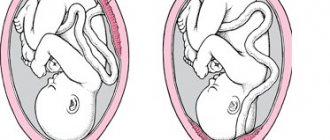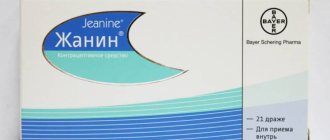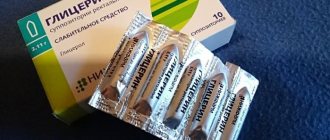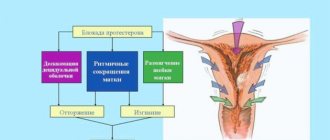Pharmacological properties of the drug Proginova
Proginova contains estradiol valerate, a precursor to natural 17β-estradiol. While using the drug Proginova, ovulation is not inhibited and taking the drug has almost no effect on the endogenous production of hormones. With the onset of menopause, the synthesis of estradiol in the ovaries decreases and gradually stops, which can lead to disruption of thermoregulation, which causes hot flashes, sleep disturbances and excessive sweating, atrophic changes in the urogenital tract with symptoms of dry vaginal mucosa, dyspareunia and urinary incontinence. Less specific symptoms: angina pectoris, palpitations, irritability, nervousness, decreased ability to concentrate, weakened memory, decreased libido, pain in muscles and joints are also components of the menopausal syndrome. Hormone replacement therapy (HRT) minimizes many of these symptoms of estradiol deficiency in menopausal women. HRT with an appropriate dose of estrogen, as in Proginova, reduces bone resorption and delays postmenopausal bone loss. When HRT is stopped, bone mass decreases at a rate comparable to that observed in the immediate postmenopausal period. HRT also has a positive effect on skin collagen content and skin density and delays the formation of wrinkles. HRT changes the lipid profile, reducing the level of total cholesterol and LDL cholesterol and increasing the level of HDL cholesterol and TG. The inclusion of a progestogen in the treatment regimen can to a certain extent affect metabolic processes. For women with a non-removed uterus, it is recommended to include a progestogen in the estrogen replacement regimen found in Proginova for at least 10 days each cycle. This reduces the risk of endometrial hyperplasia and the existing risk of developing adenocarcinoma. Including a progestogen in an estrogen HRT regimen does not reduce the effectiveness of estrogen. Based on data from studies using a combination of conjugated equine estrogens with medroxyprogesterone acetate, it is assumed that the incidence of colon cancer in postmenopausal women receiving HRT is reduced. After oral administration of estradiol valerate is rapidly and completely absorbed. During absorption and first passage through the liver, the steroid ester is broken down into estradiol and valeric acid. At the same time, estradiol is metabolized into estrone, estriol and estrone sulfate. Only about 3% of estradiol becomes bioavailable after oral administration of estradiol valerate. Eating food does not affect the bioavailability of estradiol. The maximum concentration of estradiol in the blood serum is 15 pg/ml (or 30 pg/ml) and is usually achieved 4–9 hours after taking the pill. During the day after taking the pill, the level of estradiol in the blood serum decreases to 8 pg/ml (or 15 pg/ml). Estradiol binds to serum albumin and sex steroid binding globulin (SHBG). About 1–1.5% of estradiol circulates as a free steroid, 30–40% is bound to SHBG. The apparent volume of distribution of estradiol after a single intravenous injection is about 1 l/kg. The metabolism of exogenously administered estradiol valerate occurs according to the scheme of bioconversion of endogenous estradiol. Estradiol is primarily metabolized in the liver, but also outside its boundaries, such as in the intestines, kidneys, skeletal muscles and target organs. Metabolic processes include the formation of estrone, estriol, catechol estrogens, sulfates and glucuronic conjugates of these compounds that do not have estrogenic activity. After a single intravenous injection, the rate of total clearance of estradiol from blood serum is very variable and ranges from 10 to 30 ml/min/kg. A certain part of estradiol metabolites is excreted in the bile and passes through the so-called enterohepatic circulation. Estradiol metabolites are mainly excreted in urine in the form of sulfates and glucuronides. After multiple doses, serum estradiol levels are 2 times higher compared to a single dose. On average, the concentration of estradiol ranges from 15 (or 30 pg/ml) (minimum level) to 30 (or 60 pg/ml) (maximum level). Estrone, as a less estrogenic metabolite, reaches 7 times higher concentrations in blood serum, estrone sulfate - 150 times. After the end of treatment, the levels of estradiol and estrone noted before the start of treatment are restored over the next 2-3 days.
Reviews from doctors
Doctors have different opinions:
Larisa T. 33 years old.
Gynecologist ZhK: “I rarely resort to prescribing this drug, since now there are a lot of analogues that are more gentle on the body, but life is a complicated thing, and every time it encounters certain obstacles that return us to the “old fashioned” methods.” These include allergies in women to drugs, this is also an individual condition, when the level of hormones is so low that one has to resort to powerful methods of influence, and sometimes a banal financial situation prevents a woman from buying something more worthwhile, because outdated drugs are cheaper than new ones "
Ivan O. 39 years old.
Gynecologist. IVF department: “I have not used this drug for a long time, since there are newer and less aggressive ways of influencing the reproductive organs. Proginova is a thing of the past.”
Galina K. 37 years old.
Gynecologist ZhK: “I prescribe this drug, as a rule, to women in menopause. It also removes the symptoms quite well and, oddly enough, the side effects at this age are less. But other means have long been developed for young people.”
Date: 02/04/2018
Use of the drug Proginova
Adult women, including older women. If the patient has not had her uterus removed and is still menstruating, a combination therapy regimen using Proginova and a progestogen should be started within the first 5 days of the menstrual cycle. If menstruation occurs very rarely or for postmenopausal patients, taking Proginov tablets can be started at any time, provided that pregnancy is excluded. Doses: 1 Proginova tablet daily. Taking pills Each blister pack is designed for a 21-day course of treatment. After use for 21 days, you can take a break from treatment, usually 7 days or less (cyclic HRT), or continue to take the tablets daily (continuous HRT). When choosing the last treatment regimen, tablets from a new package are taken immediately after the end of the previous package. Combination therapy For women with a non-removed uterus, it is recommended to use an appropriate progestogen for 10-14 days every 4 weeks (cyclic combined HRT) or simultaneous use of a progestogen with each estrogen tablet (continuous combined HRT). It is necessary to provide and ensure the patient's compliance with the recommended combination therapy regimen. Swallow the pills whole with a small amount of water; it is advisable to take the pills at the same time every day. The missed tablet should be taken within the next 12–24 hours. If several tablets are missed, sudden bleeding may occur.
Release form and composition
The dosage form of Proginova is tablets (21 pieces in blisters, 1 blister in a cardboard box).
1 tablet contains:
- Active substance: estradiol valerate – 2 mg;
- Auxiliary components: montanglicol wax - 0.075 mg, lactose monohydrate - 46.25 mg, talc - 2.4 mg, corn starch - 26.2 mg, povidone 25,000 - 3 mg, magnesium stearate - 0.15 mg, macrogol 6000 - 3.719 mg, crystalline sucrose - 33.54 mg, povidone 700,000 - 0.323 mg, talc - 7.104 mg, precipitated calcium carbonate - 14.572 mg, glycerol 85% - 0.205 mg, indigo carmine (E132) - 0.051 mg, titanium dioxide (E171) – 0.411 mg.
Contraindications to the use of the drug Proginova
HRT should not be started for any of the following conditions. If any of these conditions occur during HRT, use of the drug should be discontinued immediately. During pregnancy and breastfeeding. Vaginal bleeding of unknown etiology. Diagnosed or suspected breast cancer. Diagnosed or suspected precancerous conditions or malignant tumors dependent on sex steroids. Current or history of liver tumors (benign or malignant). Severe liver diseases. Arterial thromboembolism in the acute stage (for example, myocardial infarction, stroke). Exacerbation of deep vein thrombosis, current thromboembolic disorders or a history of such diseases. Severe form of hypertriglyceridemia. Hypersensitivity to the active substances or to any of the auxiliary components of the drug.
Female hormones
Normally, the male body must produce a small amount of female hormones for its normal functioning. Since the stronger sex, due to the physiological characteristics of the structure of the body, does not have ovaries, the adrenal glands take over the function of synthesizing hormonal substances. The bodies of both sexes contain substances such as estrogens, prolactin, progesterone and oxytocin, only the fairer sex produces much more of them and they perform the functions of controlling the reproductive system, mammary gland growth and maintaining pregnancy.
Female hormones perform completely different functions for men:
- Increased bone strength;
- Protection against prostate cancer;
- Regulating blood sugar and fluid balance;
- Stimulation of brain function;
- Ensuring normal sexual activity and erection.
Oxytocin has a calming effect and also lowers testosterone levels, which makes a man softer and less irritable, and also slightly reduces libido, but at the same time stimulates feelings of affection.
Side effects of the drug Proginova
The following side effects have been reported in women who have used oral HRT medications: Reproductive organs and breasts : changes in the nature of vaginal bleeding - abnormal or heavy bleeding, breakthrough bleeding, spotting (these disorders usually normalize with continued treatment); dysmenorrhea, changes in vaginal secretion, premenstrual-like syndrome, breast pain, feeling of tightness or enlargement of the mammary glands. Gastrointestinal tract: dyspepsia, bloating, nausea, vomiting, abdominal pain. Skin and subcutaneous tissues: skin rashes, itching, eczema, urticaria, acne, hirsutism, hair loss, erythema nodosum. Nervous system: headache, migraine, dizziness, anxiety, depressed mood, fatigue. Other disorders: palpitations, swelling, muscle cramps, changes in body weight, increased appetite, changes in libido, blurred vision, intolerance to contact lenses, hypersensitivity reactions.
Male hormones
Hormones produced in the male body are mainly represented by testosterone and its varieties; it is on these hormones that they depend:
- Normal development of the genital organs;
- Rougher facial features;
- Body structure and hair growth according to the male type;
- Features of behavior:
- Voice timbre;
- Sexual desire and sexual power.
If a man's testosterone level decreases, this can lead to mental depression, depressive thoughts, abdominal pain, poor health and sexual dysfunction.
Special instructions for the use of the drug Proginova
In the presence or exacerbation of any of the following diseases/risk factors, before starting or continuing HRT, it is recommended to conduct an individual analysis of the benefit-risk ratio of the drug. Venous thromboembolism The results of epidemiological and randomized controlled studies suggest that the risk of developing venous thromboembolism (VTE), that is, deep vein thrombosis or pulmonary embolism, is likely to increase. Therefore, when prescribing HRT to women with a risk factor for developing VTE, the risk-benefit ratio of treatment should be carefully weighed. Generally recognized risk factors for the development of VTE include: personal and family history (a case of VTE in a close relative at a relatively early age may indicate a genetic predisposition) and severe obesity. The risk of VTE also increases with age. The possible role of varicose veins in the development of VTE remains controversial. The risk of VTE may temporarily increase with prolonged immobilization, after major elective or major surgery, or after severe trauma. The issue of temporary cessation of HRT should be decided depending on the nature of the surgical intervention and the duration of immobilization. Arterial thromboembolism The results of clinical studies using a combination of conjugated equine estrogens and medroxyprogesterone acetate (MPA) in a continuous mode indicate a possible increase in the risk of developing coronary artery disease within 1 year of use; with continued treatment, the risk remained stable. Another negative consequence identified during therapy is an increase in the risk of stroke by 30–40% with estrogen monotherapy or their use in combination with MPA. Tumors Endometrial cancer Long-term estrogen monotherapy increases the risk of developing endometrial hyperplasia or carcinoma. Based on research results, it is believed that the appropriate inclusion of progestogens in the treatment regimen will eliminate this increased risk. Breast cancer Based on clinical studies and observations, an increased risk of developing breast cancer has been shown in women using HRT for several years. These facts may be associated with earlier diagnosis, the stimulating effect of HRT on pre-existing tumors and the combined influence of these factors. The overall relative risk of diagnosing breast cancer in more than 50 epidemiological studies conducted was generally between 1 and 2. The relative risk increases with duration of treatment and may be lower, or more likely unchanged, with estrogen monotherapy. A similar increase in the incidence of breast cancer is observed, for example, in women with a delay in the onset of natural menopause or with alcohol consumption or obesity. A few years after starting HRT therapy, the increase in risk is leveled out. It is noted that tumors identified in women who use or have recently used HRT are characterized by a higher degree of differentiation than tumors identified in women who do not use HRT. When using HRT, the density of images during mammographic examinations increases, which in some cases can complicate the diagnosis of breast diseases. Ovarian cancer According to the results of studies, a slight increase in the risk of developing ovarian cancer in women receiving HRT with estrogens for a long time (more than 10 years) has been revealed; the results of other studies deny an increase in the risk. Liver tumors After the use of hormonal drugs, including HRT, benign, and even more rarely, malignant liver tumors were observed in isolated cases. In isolated cases, these tumors caused life-threatening intra-abdominal bleeding. If there is pain in the upper abdomen, liver enlargement, or signs of intra-abdominal bleeding, the differential diagnosis must take into account the likelihood of a liver tumor. Gallstone disease Estrogens are known to increase the lithogenicity of bile. Some women are prone to gallbladder disease during estrogen treatment. Dementia Based on clinical studies using products containing conjugated equine estrogens, it has not been proven that hormonal use may increase the risk of developing dementia when treatment is initiated in women aged 65 years or older. The risk may be reduced if treatment is started early in menopause. Other conditions Treatment should be stopped immediately if migraine-like or frequent and unusually severe headaches or other symptoms that are likely prodromal signs of cerebral vascular occlusion first appear. No general association has been established between the use of HRT and the development of clinical hypertension. A slight increase in blood pressure has been reported in women receiving HRT; clinically significant increases in blood pressure have rarely been observed. However, if in some cases persistent clinically significant hypertension develops during HRT, the advisability of discontinuing HRT should be considered. For mild liver dysfunction, including various forms of hyperbilirubinemia, such as Dubin-Johnson syndrome or Rotor syndrome, patients should be under close medical supervision with periodic determination of liver function. If liver function tests worsen, HRT should be discontinued. Women with moderately elevated triglyceride levels require special monitoring. In such cases, the use of HRT may cause a further increase in TG levels, which poses a risk of developing acute pancreatitis. Although HRT may affect peripheral insulin resistance and glucose tolerance, there is generally no need to change the therapeutic regimen for diabetic patients using HRT. However, women with diabetes should be under close medical supervision during HRT. Some patients may develop undesirable manifestations of estrogen stimulation during HRT, such as abnormal uterine bleeding. Frequent or constant bleeding during treatment is an indication for examination of the condition of the endometrium. Under the influence of estrogens, the size of uterine fibroids may increase. In this case, treatment should be stopped. It is recommended to discontinue treatment if recurrence of endometriosis is observed during therapy. If you suspect the presence of prolactinoma, before starting HRT, you should exclude the possibility of this disease. In some cases, chloasma may occur, especially in women with a history of chloasma during pregnancy. When taking a course of HRT, women predisposed to chloasma should avoid exposure to the sun or ultraviolet radiation. It has been found that the following conditions and diseases may occur or worsen when using HRT. Although it cannot be confidently stated that these changes are associated with HRT, patients taking HRT who have the following diseases should be closely monitored: epilepsy; benign breast diseases; BA; migraine; porphyria; otosclerosis; systemic lupus erythematosus; chorea. Medical examination/consultation. Before starting or resuming HRT, you need to carefully study the patient's medical history and illness and conduct a physical examination, taking into account contraindications (see CONTRAINDICATIONS) and precautions (see SPECIAL INSTRUCTIONS), and periodically repeat such examinations. The frequency and nature of examinations should be based on existing standards of medical practice, taking into account the individual characteristics of the patient. As a rule, the pelvic organs are subject to examination, including standard cytological analysis of the cervix, examination of the abdominal cavity, mammary glands, and blood pressure measurement. During pregnancy and breastfeeding. Proginova should not be prescribed during pregnancy and lactation. If pregnancy occurs while taking Proginova, treatment should be stopped immediately. Clinical data, based on a limited number of cases of use of the drug during pregnancy, do not indicate a negative effect of estradiol valerate on the fetus. The results of most epidemiological studies have not revealed the teratogenic or fetotoxic effects of HRT drugs when taken accidentally during pregnancy. Small amounts of sex hormones can be excreted in breast milk. Effect on the ability to drive vehicles and operate machinery: not noted.
Interactions of the drug Proginova
The use of hormonal contraceptives should be discontinued at the start of HRT, and if necessary, non-hormonal methods of contraception should be recommended. Interaction of the drug with other drugs Treatment with drugs that affect the activity of liver enzymes (for example, some anticonvulsants and antimicrobial drugs) for a long time can increase the clearance of sex hormones and reduce their clinical effectiveness. Such liver enzyme inducing properties have been identified in hydantoins, barbiturates, primidone, carbamazepine and rifampicin, and the presence of these properties can also be expected in oxcarbazepine, topiramate, felbamate and griseofulvin. Maximum induction of enzymes, as a rule, is observed no earlier than 2–3 weeks from the start of use and persists for 4 weeks after discontinuation of the drug. In isolated cases, during concomitant use of certain types of antibiotics (for example, penicillin and tetracycline groups), a decrease in estradiol levels was observed. Substances that form conjugates (eg paracetamol) can increase the bioavailability of estradiol by competitively inhibiting conjugation systems during adsorption. In some cases, the need for oral antidiabetic agents or insulin may change due to an effect on glucose tolerance. Interaction with alcohol Excessive alcohol consumption during HRT may lead to increased plasma estradiol levels. Effect on laboratory results . Taking sex steroids may affect the results of certain laboratory tests, including biochemical parameters of liver, thyroid, adrenal and kidney function, levels of transport proteins such as corticosteroid binding globulin and lipid/lipoprotein fractions, parameters of carbohydrate metabolism, and parameters coagulation and fibrinolysis.
Destination Features
During the normal course of pregnancy, a sharp increase in the amount of estrogen occurs in a woman’s body. A common cause of infertility is a lack of your own sex hormones. To increase their quantity, the drug Proginova, containing a synthetic analogue of estradiol, is prescribed.
After obtaining a positive result during the IVF protocol, the medication is continued until 8-10 weeks of pregnancy.
The purpose of this recommendation is to maintain a sufficient amount of estrogen in the body for successful implantation and development of the embryo. Starting from the 10th week of pregnancy, the drug is gradually withdrawn. By this time, hormones are produced independently and their excessive amounts negatively affect the condition of the fetus.
Recommendations for taking Proginov in the early stages of pregnancy are relevant only after in vitro fertilization. During natural conception, there is no need to continue taking the drug, since the woman’s body produces a sufficient amount of estrogens.








